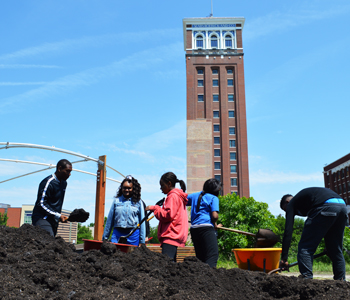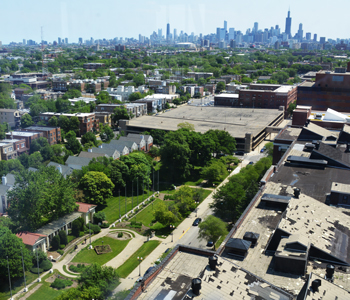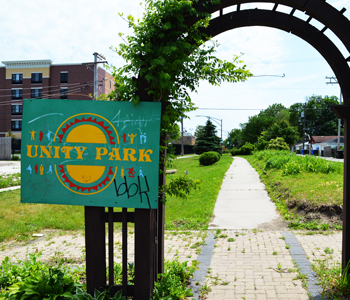In 1966, the Rev. Martin Luther King Jr. moved into an apartment on Hamlin Avenue to highlight the squalid conditions African-Americans were living in all over the country. More than a half-century later, observers both in and outside Chicago still hold up North Lawndale as an example of everything wrong with American cities.
Lawndale was the opening case study in Ta-Nehisi Coates’ 2014 “A Case for Reparations,” and newspaper headlines daily report how gun violence and opioid addiction are ravaging the neighborhood’s residents.
Despite it all, North Lawndale is sitting on assets that real estate professionals say make a comeback inevitable, if not foreseeable. The area’s 1890s heyday left it with one of the highest concentrations of historic greystone buildings in the city, and a two-mile L-shaped boulevard carves a lush green path to the 173-acre Douglas Park.
It’s one of just a few neighborhoods outside Downtown that’s accessible by two CTA rail lines, and it’s home to the 1,700-seat Central Park Theatre, one of Chicago’s most grandiose Vaudeville-era venues. Some buyers have begun to take notice, with home prices appearing to jolt in 2018 after years of flatlining.
Today, the combination of creeping interest in adjacent neighborhoods and an accelerating revitalization effort around Sears’ former Homan Square headquarters is mapping out a hopeful future for North Lawndale.
In the beginning
The eastern half of North Lawndale was annexed into Chicago in 1869, immediately becoming a home for Bohemian immigrants. Everything west of current-day Pulaski Road, an area known as “K-Town” for its alliterative street names, followed 20 years later, earning a reputation as a mini-metropolis of Czech workers and their families.
The neighborhood’s early-20th century ascendance can be tracked through the dozens of ornate houses of worship that still line its streets: Baroque-style Central European Catholic churches were joined by synagogues starting in the 1920s, and Southern Baptist congregations began setting up inside both kinds of buildings after World War II. By 1960, nearly 125,000 people lived in the 11-square-mile area roughly bounded by Western Avenue, Ogden Avenue, Cicero Avenue and Taylor Street.
But almost as soon as African-Americans began settling there, the politics of White Flight drove the neighborhood’s wealthier residents to the suburbs, hurried along by “panic-peddler” real estate investors who encouraged homeowners to sell low and fast.
The 1968 race riots that scorched the West Side after King’s assassination kicked off a domino effect of big businesses abandoning North Lawndale, most significantly Sears, which shuttered its Homan Square campus in 1974. The neighborhood’s population and wealth have been in freefall ever since.
Signs of change
Residents in the northeast corner of the neighborhood saw a turning point starting in 1989, when developer Charles Shaw drew up a redevelopment plan for the 14-story tower and surrounding brick office buildings that used to be Sears’ company headquarters.

Homan Square Community Center
Since then, the Homan Square Community Center reopened the 112-year-old tower, which is now home to a hodgepodge of nonprofits and community groups. The Shaw Technological and Learning Center opened in the company’s former power plant building, and last year Mercy Housing Lakefront completed a $65 million redevelopment with 181 affordable apartments in the company’s former mail-order plant.
In 2015, the late-summer music festival Riot Fest moved to Douglas Park, pleasing surrounding business owners and introducing thousands of young music fans to the neighborhood.

The view from Nichols Tower
In 2016, the leaders of the School of the Art Institute of Chicago decided to focus their “community engagement” efforts exclusively on North Lawndale, and they opened an office in the redeveloped Homan Square tower, now called the Nichols Tower. The school is piloting a five-year project called The Oaks of North Lawndale, modeled after a similar effort in Germany, aiming to plant up to 7,000 trees in the neighborhood by 2023.
Also in 2016, the North Lawndale Community Coordinating Council and the Chicago Metropolitan Agency for Planning began working on North Lawndale’s first comprehensive development plan in decades. A seven-chapter draft of the plan, released earlier this year, suggests chartering homeowner groups and launching a marketing push to attract outside investors, among a raft of other recommendations.
Transportation
North Lawndale is hugged by the Blue Line near its northern boundary and the Pink Line at the south, where the Central Park station drops visitors in a growing commercial district anchored by the Lawndale Christian Health Center and a Lou Malnati’s pizzeria.
At one time a nexus for a half-dozen streetcar lines, the neighborhood now sees buses run every day along Roosevelt Road, Central Park Avenue, Pulaski Road, 16th Street, Kedzie Avenue and Cermak Road.
Separated bike lanes along Central Park Avenue, Independence Boulevard and Douglas Boulevard give cyclists a continuous, if bare-bones, path through the neighborhood.
Residential take
“I grew up in Logan Square 30 years ago, and it felt kind of like what Lawndale is now — an impoverished community, but one that still had a little bit of everything,” said Moe Pacheco, an Oak Park-based broker with Baird & Warner who sells single-family homes and two-flats in North Lawndale. “It’s become a diverse community with some restaurants and grocery stores, but it hasn’t gentrified. The real estate value in Lawndale hasn’t boomed in the way that it has in neighboring areas like East Garfield Park and Tri-Taylor, which is interesting because it has more amenities and less vacant land than Garfield Park. There’s this misconception that it’s crime-ridden and you have to dodge bullets, but other than construction workers getting their tools stolen, I haven’t run into a lot of [brokers or contractors] who deal with violent crime.”

Unity Park
Commercial take
“It’s a unique, somewhat thinly-traded market,” said Niko Voutsinas, a Redfin broker who represents buyers of multifamily buildings on the West Side. “For investors who are comfortable with the business model, which is largely Section 8-oriented, it can work. What’s a little frustrating from an agent’s perspective is how little transparency there is in marketing — often it’s either a flip of a flip and the seller knows nothing about it, or it’s a landlord who’s worn out by their tenant and wants to disclose as little as possible. But the risk is baked into the prices, and you can get a steal of deal if you’re comfortable taking it on. You could get some eight-unit buildings for $250,000, and make up to a 20 percent annual return.”
Demographics
2015 population: 35,276 (down 1.8 percent since 2010)
Median age: 28.6
Median income: $22,383
Average residential sale price within the last 12 months
$79,250 — $64 per square foot
Average current residential listing price
$120,000 — $67 per square foot
Priciest residential sale
1672 South Albany Avenue — $461,000
Most expensive home on the market
2546 West Grenshaw Street — $550,000
Least expensive home on the market
1428 South Kedvale Avenue — $34,900
Price trends (Redfin)
North Lawndale’s median home sale price shot up by 73 percent between June 2017 and June 2018, jumping from $60,000 to $104,000. That was after a 20 percent bump between June 2014 and June 2015, a 25 percent spike from 2015-16 and no recorded change between June 2016 and June 2017.
The neighborhood’s June 2018 median home sale price was about one third of the city’s overall median ($302,000), and 40 percent of the Chicago region’s median ($263,000).
New development
Large-scale development has been scarce in North Lawndale, but big projects in neighboring areas suggest shovels could be headed its way.
To the north in Garfield Park, a 67,000-square-foot food incubator called The Hatchery is under construction at Lake Street and Kedzie Avenue, and Garfield Park Chamber of Commerce CEO-turned-developer Siri Hibbler is proposing a 114-unit mixed-use complex called Rebirth Garfield Park at Madison Street and California Avenue.
And in neighboring Tri-Taylor, nine separate projects are underway on a 10-acre plot being called “The Gateway” next to Stroger Hospital. They’re projected to open a combined 1.26 million square feet of apartments, offices, hospitality and retail during the next several years.
